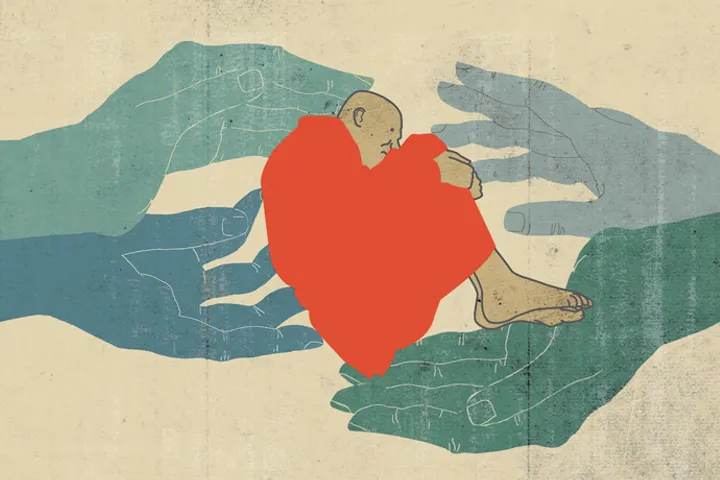Most of us are taught from a young age to say no to things that are overtly dangerous or problematic—whether it be playing catch in busy street or giving personal information to a stranger. But what we’re not often taught is when to say no to neutral or even good things.
 Illustration by Abbey Lossing
Illustration by Abbey Lossing
Maybe you’re a parent with a full-time job, and you struggle knowing whether to respond to an important email or head home to your family. Maybe you’re a remote employee who feels pressure to be online beyond the typical nine-to-five workday. Maybe it’s simply that you’re a woman who’s been taught that saying yes equates to being nice, agreeable, and helpful. Between societal pressures, cultural norms, social expectations, and the development of 24-hour connectivity, it’s no surprise that we find ourselves going along with more than we should.
We put together this guide to help you become aware of your yesses and nos and discover more balance in life. Our goal is not to eliminate “Yes” from your vocabulary, but to make saying “No” a little more comfortable and meaningful.
“No” Is Essential
As human beings, we can’t say yes to whatever we want. We have finite time, energy, and resources, but many of us haven’t had anyone model how to set healthy limits. This may explain the popularity of Christian psychologists Dr. Henry Cloud and Dr. John Townsend’s bestselling series of books on boundaries. Published in 1992, their first book—Boundaries—sold over 4 million copies and was the precursor to the rest of the series, which suggests readers do want to balance their yes and their no.
Cloud and Townsend write that learning how to say no is essential to making healthy life choices. When we’re consistently saying yes, we become physically and emotionally overextended, and we’re also not heeding God’s Spirit within us. Being in His presence and following His lead is the way to find fullness of joy (Psalm 16:11). When we say no, we honor our God-given free will and His leading instead of allowing other people and their agendas to run our life. It means we’re paying attention to Him and the desires He’s given us—rather than satisfying some outside obligation or expectation.
One additional consideration: For those who have a history of dysfunctional family dynamics, trauma, or high control backgrounds, setting healthy boundaries is especially critical to our wellbeing.
“No” Is Stewardship
Healthy boundaries help us see how our no is an act of life stewardship. We can say a confident “No” when we understand what is ours to do and what isn’t. God gave us boundaries that limit our days to 24 hours and our week to six days of work with a Sabbath rest. God also made our bodies with limits—the rhythms of regular sleep and frequent nourishment affect our capacity in real ways. We need to honor our human limitations by taking cues from the natural boundaries of time and body.
Another way of thinking about stewardship considers our highest contribution in every area of our life. We can’t do everything, so what is essential? Where do we contribute most effectively and with the greatest purpose?
If those questions feel overwhelming, start with the day at hand. Ask yourself, What is essential today? In other words, which of your core values (spirituality, family, friendship, service, etc.) do you want to prioritize before the day is over? Spend a moment or two in awareness of the Holy Spirit and ask for His guidance.
Once you’ve decided what’s essential, let go of everything else. Allow yourself to feel assured and at peace with your choices, trusting God to guide and correct you as needed.
Greg McKeown, author of New York Times bestseller Essentialism, writes, “Only once you give yourself permission to stop trying to do it all, to stop saying yes to everyone, can you make your highest contribution towards the things that really matter.” Jesus models this throughout the Gospels when He makes choices about when He prays versus when He teaches; when He requires solitude versus when He meets the crowds; whom He chooses to heal versus whom He does not. We can follow His example.
“No” Is Seasonal
When learning to say no, it’s also important to account for our season of life, which will change over time. How we steward our time and capacity will be affected by things like caregiving duties, our physical health, resources, or big life changes. We need to allow ourselves the flexibility to reassess regularly and decide if our “No” is still healthy and appropriate. Author Kate Bowler, who lives with a cancer diagnosis, says that for those who live with limitations, it’s “a blessing when you have to learn to say ‘no.’” In one of her blessings, she writes, “Bless you as you ask for the help you so readily give. / May you be met with the same love that you’ve always poured out. / May you find ways to give still / that fit the shape of today’s available spoons. / Not more, not less. / Just what’s right for now.” When deciding if we should say no, we might ask ourselves, What fits the shape of my available ‘spoons’ in this season?
“No” Is Beautiful
For many of us, when we have summoned the courage to say no, it’s been met with a healthy dose of guilt or offense by the other party. We can learn how to say no more effectively by embracing the idea that “No” can be beautiful and honors ourselves as well as those who receive it. In 2020, the Pure Leaf Tea company created a “No is beautiful” campaign for their products. The company says no to adding anything harmful, artificial, or less than ideal to its products. No is an important part of keeping things at their best, without additives that distort the flavor of life. Our no protects the life we want to steward well.
Next time you face a decision, try imagining the results of your yes and the results of your no. How might the story play out?
Which answer frames the story for an outcome that honors both the Holy Spirit and your values?
It may be helpful to look back and recall a time when a no would have been the healthier and more loving choice for all involved.
“No” Is Integrity
Once we decide to set boundaries to steward our lives well, understand the beauty of saying no, and reframe our stories, we’re in a strong position to put what we’ve learned into practice. What does this look like on a daily basis? James 5:12 shows us that when we speak our yes and our no, it is enough. We don’t need to make elaborate promises or multiple excuses. Our answers are rooted in our integrity and, as such, stand on their own. When we commit to an answer and follow through, this is a sign of spiritual maturity. Communicating our no clearly is also a kindness to both ourselves and the other party involved. And it’s important to remember we’re responsible for what we say but not how the information is received.
“No” Takes Practice
Whenever you’re ready, you might find that actually saying “No” is uncomfortable. That’s okay—most things feel unnatural or awkward at first. Here are some suggestions to help you get started:
Start small. Begin by saying no to small requests as you’re able, and in time it will become easier to determine when and how to say no to bigger things.
Have a bank of simple no statements ready to go, and practice using them. Consider using the following examples: No, thank you. Not at this time. Thank you, but I can’t.
Avoid overexplaining yourself or beginning with an apology. This unnecessarily weakens your no, especially when speaking to children.
If communicating in person, maintain eye contact and speak clearly and calmly. This helps the other person understand that you mean your “No” and eliminates confusion.
Celebrate your no. When you succeed in declining a small request, give yourself a reward—like an afternoon tea you wouldn’t normally have or proudly telling a friend about your accomplishment. This will keep your no from feeling like a negative experience.
Go “analogue.” If you feel pressured to check your digital calendar and give an immediate answer, it can lead to a hasty yes. Instead, try using a paper calendar that stays at home, which will give you time to make a more informed decision.
Worth Your “Yes”
Saying no allows us to offer a meaningful yes to the people, projects, and plans that matter most. Christian author and speaker Lysa TerKeurst quotes Louie Giglio in her book The Best Yes: “Whenever you say yes to something, there is less of you for something else. Make sure your yes is worth the less.” So when you think something may be worth your yes, pause and take inventory:
How does saying “yes” feel in your body? In other words, does it give you energy? Make you excited? Cause nervousness or dread? Though physical reactions by themselves shouldn’t determine our course, they’re important for us to be aware of in decision-making.
Consider your motivations. Would you be saying yes out of requirement, pressure, habit, or fear? Out of desire? See if you can pinpoint exactly why you want to say yes.
Return to your values. Which of your values, whether current or those you aspire to, does this yes support?
Think ahead. What would a yes mean for right now, and what would it mean for later? For example, the beginning can be challenging, and the payoff may not be apparent until much later. Can you work through the messy middle to see something through to completion?
The Hard Yes
Not all of our yesses are going to be exciting opportunities. Some may require us to accept ourselves, situations, and other people just as they are, not as we wish them to be. And a yes might be painful even when it’s the right decision, such as ending a harmful relationship, forgiving someone who hurt us, or giving away limited time or resources.
In situations like these, try actively giving consent to God’s presence and action in your life. Some faith traditions use a Welcoming Prayer as a resource to welcome everything that comes one’s way. If you’d like to try it, the Welcoming Prayer involves three steps:
Observe your feelings. How do you feel in this very moment? Is something on your mind?
Welcome your feelings. This does not mean we’re condoning or supporting negative emotions. To welcome is to accept that your feelings are real and present in your life. You might say, for example, “God, You see my anxiety.”
Let go. You can say, “Lord, I give You my anxiety.”
Keep Listening
No matter your inclination—whether you’re quick to say no or you jump at every opportunity—a balanced life is a worthy pursuit. And at its core, making wise decisions is about one thing: listening to God. The more you practice listening for the Spirit’s voice, the greater your ability to hear Him will become. In some seasons, that growth will be slow; in others, it might accelerate. But in all our attempts, the good news is that even when we make mistakes, God is there with us. And He doesn’t begrudge us for doing our best to follow Him, even if we falter. Don’t be afraid. His love will always carry you through.





